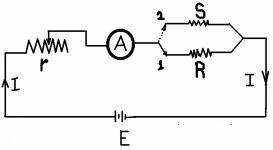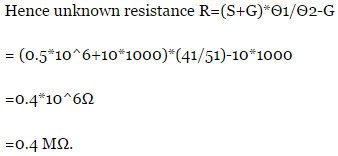Substitution Method for measuring Medium Resistance:
The connection diagram for substitution method is shown in figure below. R is the unknown resistance while S is a standard variable resistance. ‘A’ is an ammeter and ‘r’ is a regulating resistance. There is a switch for putting R and S into the circuit alternately.
The switch is put at position ‘I’ and resistance R is connected in the circuit. The regulating resistance r is adjusted till the ammeter pointer is at a chosen scale mark. Now, the switch is thrown to position ‘2’ putting the standard variable resistance S in the circuit. The value of S is varied till the same deflection as was obtained with R in the circuit is obtained. The settings of the dials of S are read. Since the substitution of one resistance for another has left the current unaltered, and provided that the emf of battery and the position of r are unaltered, the two resistances must be equal.Thus the value of unknown resist R is equal to the dial settings of resistance S.
Must Read:
- Measurement of Resistance | Ammeter-Voltmeter Method
- ElectrodynamometerInstruments Construction and Operation
- Kelvin Double Bridge Method for Low Resistance Measurement
This substitution method than the Ammeter-Voltmeter method, as it is not subject to the errors encountered in the latter method. However, the accuracy of this method is greatly affected if there is any change in the battery emf during the time the readings on the two settings are taken. Thus in order to avoid errors on this account, a battery of ample capacity should be used so that its emf remains constant.
The accuracy of the measurement naturally depends upon the constancy of the battery emf and of the resistance of the circuit excluding R and S, upon the sensitivity of the instrument, and upon the accuracy with which standard resistance S is known. This method is not widely used for simple resistance measurements and is used in a modified form for the measurement of high resistances. The substitution method principle, however, is very important and many applications in bridge methods and in frequency a.c. measurements.
Example:
1.In a measurement of resistance by substitution method a standard 0.5 MΩ resistor is used. The galvanometer has a resistance of 10KΩ and gives deflections as follows :
(i) With standard resistor, 41 divisions,
(ii) With unknown resistance, 51 divisions.
Find the unknown resistance.
Solution:
The deflection of the galvanometer is directly proportional to the current passing through the circuit and hence is inversely proportional to the total resistance of the circuit. Let S, R and G be respectively the resistances of standard resistor, unknown resistor and the galvanometer. Also let Ѳ1 be the deflection with standard resistor in circuit and Ѳ2 with unknown resistor in circuit.
If you like this article on Measurement of Medium Resistance by Substitution Method please share it facebook,twitter,g+ ,Pinterest etc.. because the only thing we can share in this world is knowledge.

